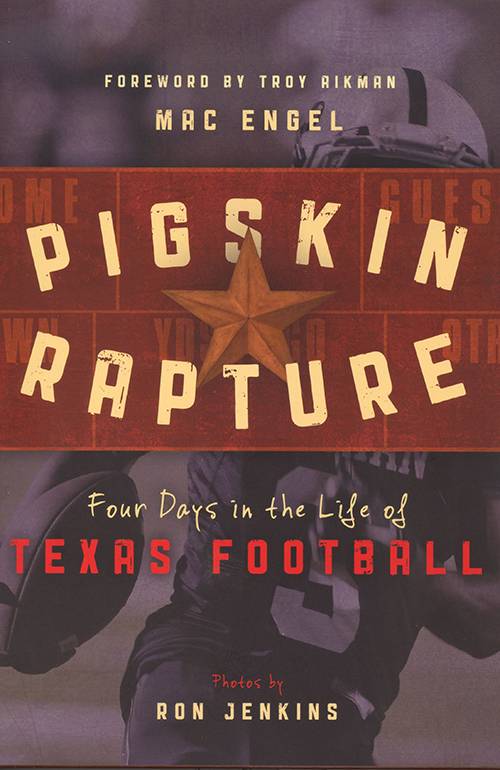For the Love of Texas Football

Pigskin Rapture: Four Days in the Life of Texas Football
by Mac Engel
Guilford: Lone Star Books, 2016.
240 pp. $26.00 cloth.
Reviewed by
James Wright
As I sit down to write this review of Mac Engel’s Pigskin Rapture: Four Days in the Life of Texas Football, Texas’s two professional football teams, the Houston Texans and the Dallas Cowboys, have just been eliminated from the NFL playoffs on the same weekend. While the expectations for the Texans were limited by both the quality of their opponent—the Tom Brady-led juggernaut New England Patriots—and by the perennial break-even performances of the team over the course of their decade-and-a-half existence, the Dallas Cowboys had put two decades’ worth of relative mediocrity behind them and were considered a lock by most pundits to represent the NFC in Super Bowl LI in the host city of Houston.
A week before the Texans and Cowboys skedaddled out of the playoffs, the Clemson Tigers upset the Alabama Crimson Tide for the NCAA National Championship. Not a single college football team from Texas caught a whiff of the four-team championship playoff. Nor did a team from the fecund football fields of Texas finish the 2016-17 season ranked in the final AP Top 25 poll.
Of course none of these facts, and the widespread and many-colored tales of woe used to bemoan them, gets in the way of the state’s otherworldly obsession with and unyielding dedication to football. On the contrary, they only serve to ratchet up the hopes and passions of those Texans who love the game—to be a Texan who loves football is to have a religious devotion to it. And, if I may be forgiven for following this provincial syllogism through to its conclusion, to be a Texan is to love football.
With Pigskin Rapture, as the title indicates, Mac Engel examines, practices, and proselytizes for this de facto state religion. Characterized by Engel as an effort “to prove whether or not the myth and perception of football in [Texas] is as grand and important as it is perceived to be by outsiders, or if it’s just an exaggerated view hyperbolized by pop culture and the media,” Pigskin Rapture is a concentrated look into the properties—material and spiritual—and customs—profane and sacred—that make up Texas football. In early October 2015, Engel, a longtime columnist for the Fort Worth Star-Telegram, with the help of veteran Dallas-area news photographers Ron Jenkins and Michael Ainsworth, set out on what would amount to a journalistic novelty in most states but could easily pass as a standard practice in Texas: to cover four noteworthy football games in four days. The result is an entertaining romp through the sights, sounds, and rituals of a game to which Texans, in small towns and big cities alike, have such a steadfast attachment.
Beginning in Houston on October 8 for the Texans’ Thursday-night game against the Indianapolis Colts and their Houston-bred star quarterback, Andrew Luck, Engel travels to the Midland-Odessa area for Odessa Permian’s Friday-night homecoming game against archrival Midland Lee. Saturday afternoon finds Engel in Dallas for the fever-pitched fervor of the Red River Rivalry game between Texas and Oklahoma. Engel wraps up his four-day jaunt on Sunday afternoon at JerryWorld to see the Cowboys against the New England Patriots.
The periods between cities and games are used by Engels to infuse local color. Engel drops by the University of Houston’s stadium before UH’s game against SMU in what would become a 13-1 Peach Bowl-winning season for the Cougars; listens to locals of the Midland-Odessa area wax nostalgically about the area’s high school football glory years; and he visits a Baptist church in Fort Worth on the morning of the Cowboys game to gauge its level of adherence to the state proverb that “Sunday belongs to God and the Cowboys, and not necessarily in that order.” There is also an interesting account of visiting Jerry Jones’s perch, a room above the owner’s suite at AT&T stadium.
Legendary Cowboys quarterback Troy Aikman, in his foreword to the book, calls football “a vital piece of the fabric and the morale of everyday life [in Texas] in a way that, because of the size of this state, no other place can match.” Aikman’s words are made manifest by Engel’s intensive survey of some of the revered institutions and practices of Texas football. With Engel’s perceptive coverage, in its erudite contextualization and skillful storytelling, and Jenkins’s and Ainsworth’s corresponding photographs, a slick array of culture-catching stills and pulsating action shots, Pigskin Rapture captures the unmatched social impact of football on identity and community in Texas.
Despite its lean years of late, Texas football will undoubtedly rise again. Commensurate to the state’s religious zeal for the sport is an irrepressible level of talent and money—at all levels—that makes for a likely resurrection, the signs of which are already appearing: UT, the blue-blood of Texas college football, is attempting to turn their troubles around with the recent hiring of coaching wunderkind Tom Herman, formerly of UH; the Texans are a quarterback away (but aren’t they always?) from a more-lasting stay in the playoffs; the Cowboys appear primed for years of success with their talented group of young players. And if for some reason these signs turn out to bear false meanings? That is no matter: as Engel expressively documents in Pigskin Rapture, the devotion of the faithful will continue to carry the day in this holy land of football.
James Wright is Houston regional editor for Texas Books in Review. He teaches composition and literature at Houston Community College.
